Javier Lesaca
Introduction and objectives
On 1 July 1937, the front cover of the German weekly “Der Stürmer” (“The Forward” or “The Striker” in German) published the image of a beast with big ears and a prominent nose resting its claws on a map of the world. The beast wore a Star of David on its breast and its arms were tattooed with dollar and pound signs (image 1). Under the image the following text appeared: “The Jews are our disgrace”.
On 5 September 2020, a digital platform under the name of “The Daily Stormer” (translation of the original in German, “Der Stürmer”) published a report suggesting that Facebook CEO, Mark Zuckerberg, ran his company’s communication strategy along the lines of a supposedly ‘Jewish’ agenda. The report was illustrated with a caricature of a devilish being with big eyes and nose, bloodshot eyes and a Kippah on its head with the Star of David (image 2).


This report sets out to define the main, and common, characteristics that define contemporary digital platforms that create and disseminate hate speech. It also provides evidence and indicators to analyse the intentionality and the political implications of these platforms in the governance and social cohesion of liberal democracies.
The study has compiled and analysed 131 examples of anti-Semitic hate published in 2020 (up to September) by a total of 50 websites. Likewise, 67 examples of anti-immigration hate created on 20 websites have been compiled and analysed over the same period. Eleven of them publish both anti-Semitic and anti-immigration content.
The results of this analysis unit provide indicators to validate the hypothesis that contemporary digital platforms that create and disseminate hate speech like “The Daily Stormer” share at least three common characteristics:
- A lack of transparency regarding their origins, the people behind them and their funding.
- The dissemination of narratives against scientific thinking.
- The dissemination of openly anti-system narratives aimed at eroding the credibility of the social contract of liberal democracies and fostering the ideological polarisation of society.
The analysis of this content suggests that the widespread launching of digital platforms to disseminate hate speech may be linked to the rise of an anti-modern and anti-liberal political movement seeking to destabilise cohesion among liberal democracies, mainly in Europe and the United States.
Analysis unit
The analysis unit for this study was obtained by eight months’ observation (January–September 2020) of the content of 50 potentially malicious websites, mainly located in Europe, North Africa and Latin America. The sample also includes digital sources located in Japan, Hong Kong, Turkey, Iran and Russia. As shown in Table 20, most of the websites analysed are hosted in Spain and the United States.
Table 20 shows a list of the digital platforms analysed, in descending order of anti-Semitic hate items detected, plus the place of origin.
In terms of detecting hate speech against the immigrant community, twenty potentially malicious websites were selected (14 of them in Spain) and individualised follow-up took place in the first eight months of 2020 to detect examples of hate towards the immigrant community. Table 21 shows a list of digital platforms analysed, in descending order of activity, including information on the geographical location where the platform is hosted. In 11 of these 20 platforms, hate messages against both the immigrant community and the Jewish community were detected at the same time. These eleven platforms are: Democracia Nacional (Spain); El Cadenazo (Spain); El Espía Digital (Spain); Verdad y Paciencia (France); The Daily Stormer (unknown); Eladio Fernandez (Spain); Muelgas Gaitán (unknown); Vdare (USA); El Español Digital (Spain); Falsas Banderas (Spain), and El Expreso de Media Noche (Spain).
Lack of transparency
The content of the “The Daily Stormer” website (https://dailystormer.su/) mainly comprises news items generated in the United States: content in English on the US presidential electoral campaign, racial incidents, the Covid crisis… Nevertheless, this platform’s server is hosted on the “.su” domain (Soviet Union). This domain was created in 1991 for the USSR just months before it collapsed. The server is currently run by the Russian Institute for the Development of Public Networks, although anyone anywhere in the world can buy an “.su” domain address. Locating the domain in a different country from the website’s target audience is just another indicator of the total lack of transparency of “The Daily Stormer”.
At no time does it provide information on who is responsible for the website, who is behind it, and where the news items come from.
The anonymity and lack of transparency offered by new digital platforms is embraced by 59 per cent of websites that publish anti-Semitic hate content analysed for this report. In the case of digital platforms that create and disseminate hate content against the immigrant community, lack of transparency is a common feature, in this case by 55 per cent of the websites analysed.
Table 20: List of digital platforms analysed, in order from highest to lowest number of anti-Semitic hate contents published
| Plataforma | Contenidos detectados | Origen | |
|---|---|---|---|
| 1 | Unz | 19 | USA |
| 2 | Muelas Gaitan | 10 | Unknown |
| 3 | Veterans Today | 8 | Unknown |
| 4 | El Cadenazo | 6 | Spain |
| 5 | Daily Stormer | 5 | Unknown |
| 6 | HispanTV | 5 | Iran |
| 7 | Resumen Latinoamericano | 5 | Unknown |
| 8 | Verdad y Paciencia | 4 | France |
| 9 | AH Tribute | 4 | Turkey |
| 10 | Benjamin Fullord | 4 | Japan |
| 11 | Global Research | 4 | Canada |
| 12 | Henry Makow | 4 | Bahamas |
| 13 | La Verdad Oculta | 4 | Argentina |
| 14 | Contrala Propaganda Mediática | 3 | Unknown |
| 15 | Democracia Nacional | 3 | Spain |
| 16 | Rafapal | 3 | Spain |
| 17 | Vdare | 3 | USA |
| 18 | Resumen Latlnoamencano | 3 | Spain |
| 19 | The Occidental Observer | 3 | USA |
| 20 | NOIRG | 2 | USA |
| 21 | Vida latinoamericana | 2 | Argentina |
| 22 | Falsas banderas | 2 | Spain |
| 23 | El Arconte | 1 | Spain |
| 24 | Kontrainfo | 1 | Spain |
| 25 | El Espía Digital | 1 | Spain |
| 26 | Selenita Consciente | 1 | Spain |
| 27 | Radio HC | 1 | Cuba |
| 28 | What Does It Mean | 1 | USA |
| 29 | Acratas.net | 1 | Spain |
| 30 | Adversario Metapolítico | 1 | Unknown |
| 31 | Asia Times | 1 | Honk Kong |
| 32 | Cazas y Helicópteros | 1 | Unknown |
| 33 | Eladio Fernández | 1 | Spain |
| 34 | Kaos en la Red | 1 | Spain |
| 35 | Kenzocaspi | 1 | Unknown |
| 36 | La Falange | 1 | Spain |
| 37 | Movimiento Político Resistencia | 1 | Spain |
| 38 | Oriental Review | 1 | EEUU |
| 39 | Ruben Hernandez Internacional | 1 | Unknown |
| 40 | Super Ocho | 1 | Argentina |
| 41 | El Español Digital | 1 | Spain |
| 42 | Europe Reloaded | 1 | USA |
| 43 | Mente Alternativa | 1 | Spain |
| 44 | Richard Silverstein | 1 | Desconocido |
| 45 | Strategic Culture | 1 | Russia |
| 46 | Takimag | 1 | USA |
| 47 | Voltaire | 1 | France |
| 48 | Amos del Mundo | 1 | Argentina |
| 49 | Zero Hedge | 1 | Bulgaria |
| 50 | National Justice | 1 | USA |
Table 21: List of digital platforms analysed, in order from highest to lowest number of anti-immigration hate contents published
| Plataforma | Contenidos detectados | Origen | |
|---|---|---|---|
| 1 | Democracia Nacional | 19 | Spain |
| 2 | Zero Hedge | 14 | Bulgaria |
| 3 | Alerta Nacional | 5 | Spain |
| 4 | Eladio Fernandez | 3 | Spain |
| 5 | Muelas Gaitán | 3 | Unknown |
| 6 | Vdare | 3 | USA |
| 7 | El Cadenazo | 2 | Spain |
| 8 | El Espía Digital | 2 | Spain |
| 9 | Verdad y Paciencia | 2 | France |
| 10 | El Expreso de Media Noche | 2 | Spain |
| 11 | Alerta Digital | 2 | Spain |
| 12 | El Correo de España | 2 | Spain |
| 13 | Daily Stormer | 1 | Unknown |
| 14 | El Español Digital | 1 | Spain |
| 15 | Astillas de Realidad | 1 | Spain |
| 16 | Caso Aislado | 1 | Spain |
| 17 | Falsas Banderas | 1 | Spain |
| 18 | The Duran | 1 | Cyprus |
| 19 | Hispania Eterna | 1 | Spain |
| 20 | Pensares Gratis | 1 | Spain |
Hate content and pseudoscience
Scientific evidence, the scientific method and rational thinking were the elements behind the Enlightenment, liberal revolutions and -later- the modern Nation States that gave rise to the liberal democracies in Europe and the United States. People’s trust in scientific evidence is the cornerstone on which their confidence in the institutions and the Administration of a modern State is built. Therefore, the creation and dissemination of narratives that are openly pseudo-scientific and anti-scientific can have a strong impact on the governance and social cohesion of a liberal democracy. They are, therefore, strongly anti-system.
The defence of this kind of narrative, contrary to scientific evidence, is a recurring feature in most of the websites we analysed that generate hate content against the Jewish or immigrant communities. Specifically, 71% of these platforms disseminate anti-Semitic content and also spread pseudo-scientific messages (in the last few months, mainly related to the Covid 19 pandemic). In the case of websites analysed for their hate content against the immigrant community, 90% have also published content challenging scientific evidence.
The combination of hate narratives against racial, religious and social groups and others contrary to scientific thinking and evidence is an indicator suggesting that contemporary platforms that generate messages of hate may be following a strongly anti-system agenda to weaken social cohesion and people’s trust in the institutions of liberal democracies. Constantly sending digital messages to polarise or criminalise certain communities of citizens, and messages that question the credibility of the cornerstone of the modern State (reason) may have far-reaching implications for governance and social cohesion in our liberal democracies.
This hypothesis is reinforced by the analysis presented below, where we make a detailed examination of the main themes and arguments used to caricature and dehumanise religious, racial or social groups.
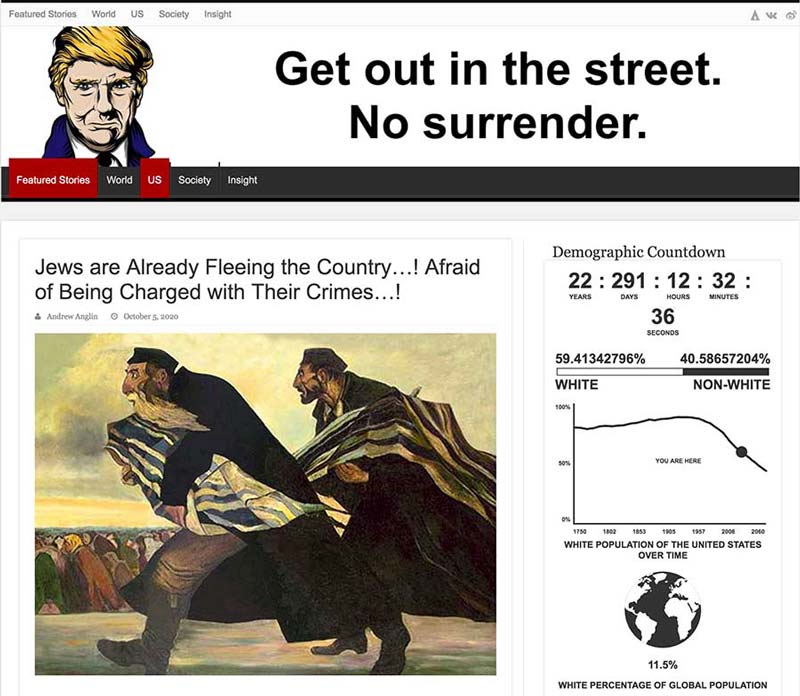

Examples of the combination of hate and pseudo-scientific narratives from the websites analysed

Jewish Privilege
The Unz. 19 July 2019

Pseudo-scientific contect
Was Coronavirus a Biowarfare Attack Against China?
The Unz. 13 March 2020

Hate message content
Jewish-Masonic conspiracy – The last moment of lucidity was 100 years ago.
Muelas Gaitán.
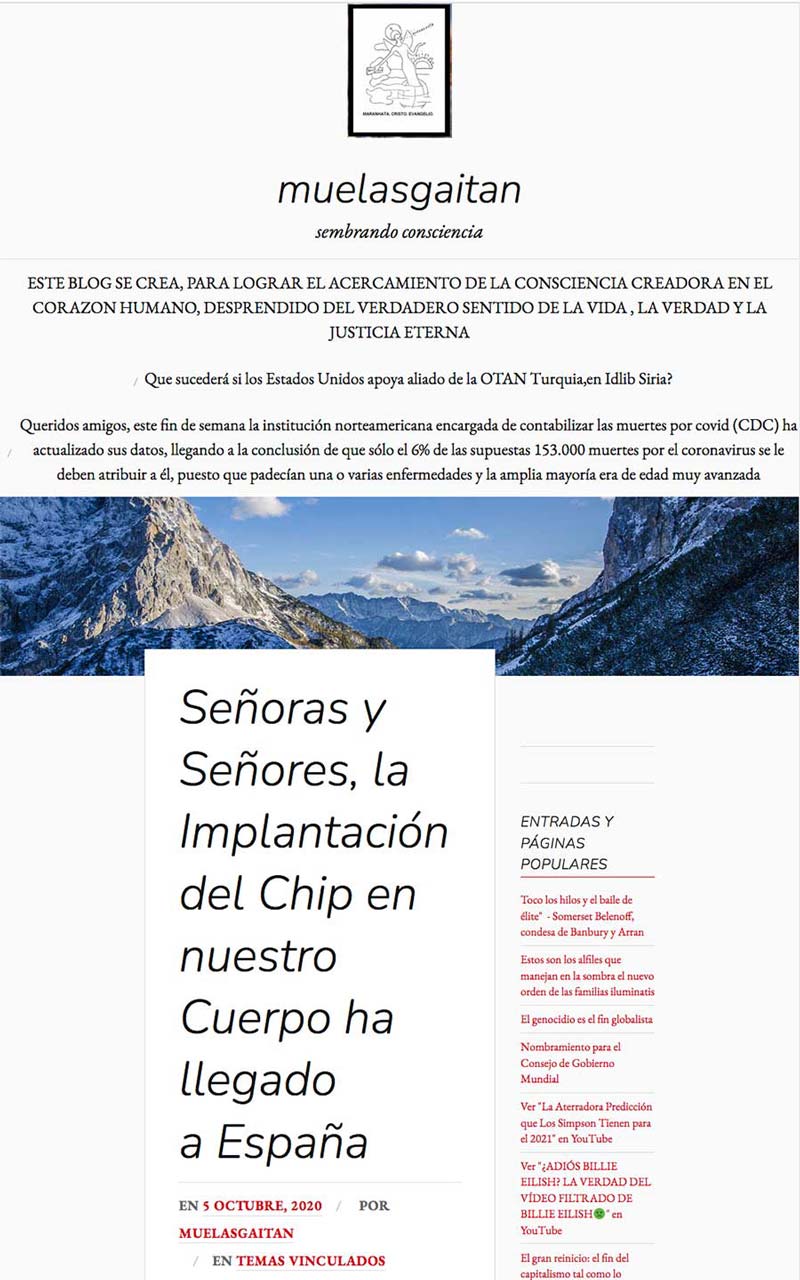
Pseudo-scientific contect
Ladies and gentlemen, the planting of chips in our bodies has reached Spain.
Muelas Gaitán. 5 October 2020
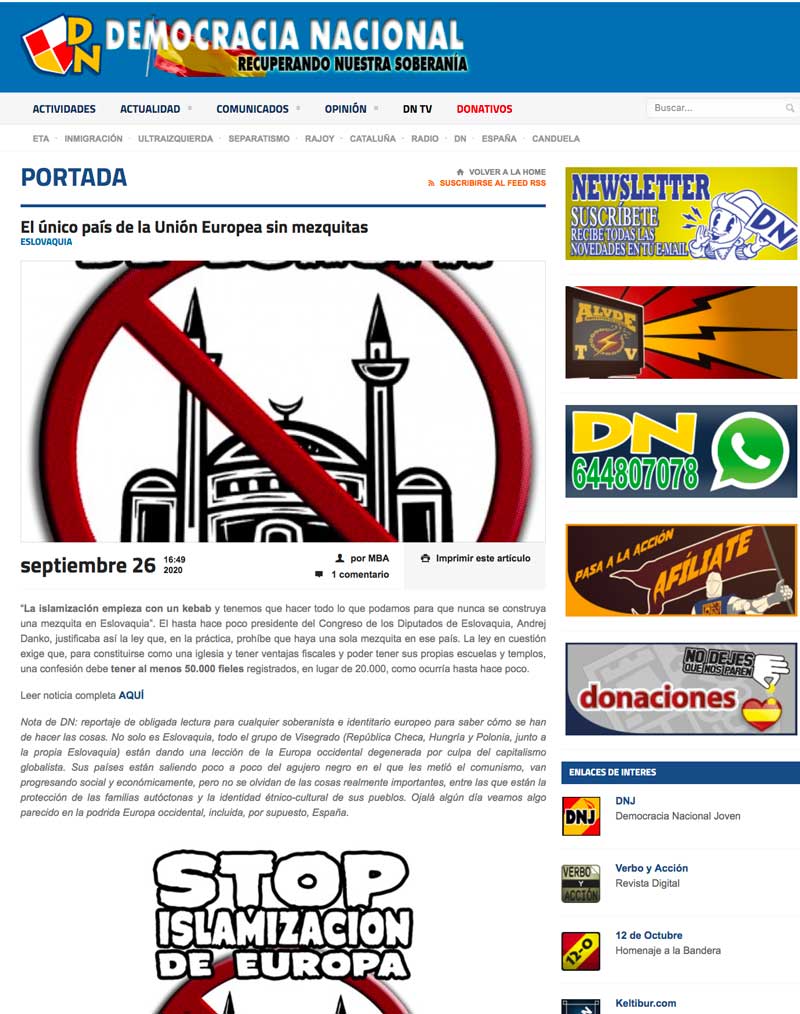

Hate and anti-system messages / attacks on
Narratives that generate messages of hate against religious, racial or social communities, or that express a strong dislike of certain groups of citizens, have a marked agenda aimed at eroding the credibility of institutions and administrations that form the basis of liberal democracies.
In-depth analysis of the main themes used to discredit both the Jewish and the immigrant communities reveals that, as well as trying to discredit these groups, there is a clear intention to erode the credibility of key institutions to prevent liberal democracy from running correctly: the financial system; national sovereignty; the media; the security forces and the judiciary system, and the health or education systems.
This evidence, plus the aforementioned comments on pseudo-scientific narratives, points to the hypothesis that there is a political motive behind narratives that generate messages of hate, seeking to destabilise and discredit liberal democracies, mainly in Europe and the United States.
a) Messages of hate and narratives to erode the financial system
Trust in the financial system and the market economy is one of the pillars of European and North American liberal democracies. Messages of hate from malicious websites frequently question the transparency of this system, disseminating content suggesting that certain racial or religious groups control the financial system with malicious intent. However, not only does it question the credibility of the financial system, which is not flawless, but it also appeals to the historical hate of Jews as evil beings who are taking over the financial system worldwide. This kind of narrative, which identifies certain racial communities with manipulation of the financial system, also ties in messages of hate generated in 21st-century Europe by publications like “Der Stürmer” (image 3), which suggest that the Jews control the economic systems, both capitalist and communist.
Some websites suggest that certain racial or religious groups control the financial system with malicious intent
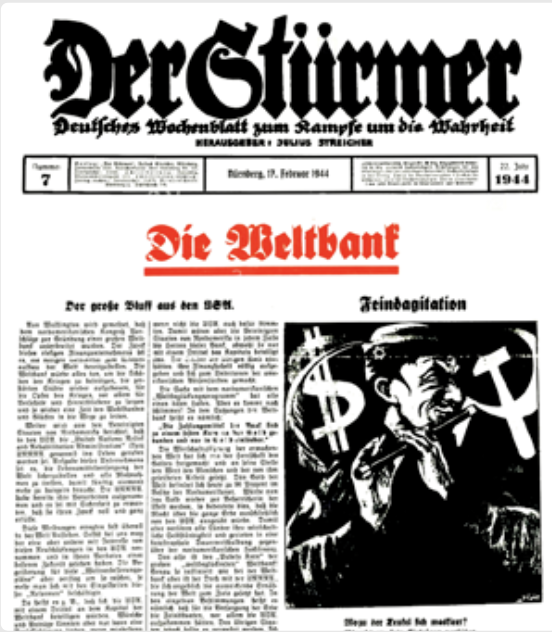
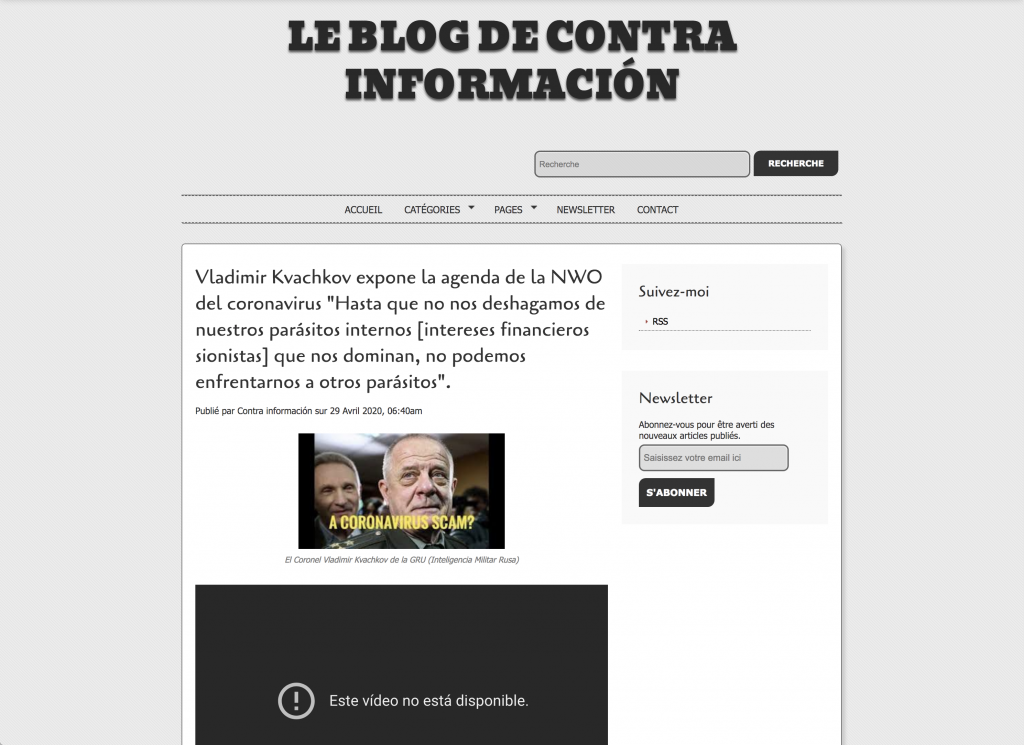
Contemporary examples of hate speech linked to narratives on the erosion of credibility of the financial system
Vladimir Kvachkov pushes NWO’S agenda on coronavirus “Until we get rid of the internal parasites [Zionist financial interest] that dominate us, we cannot take on other parasites”.
Verdad y Paciencia. 29 April 2020
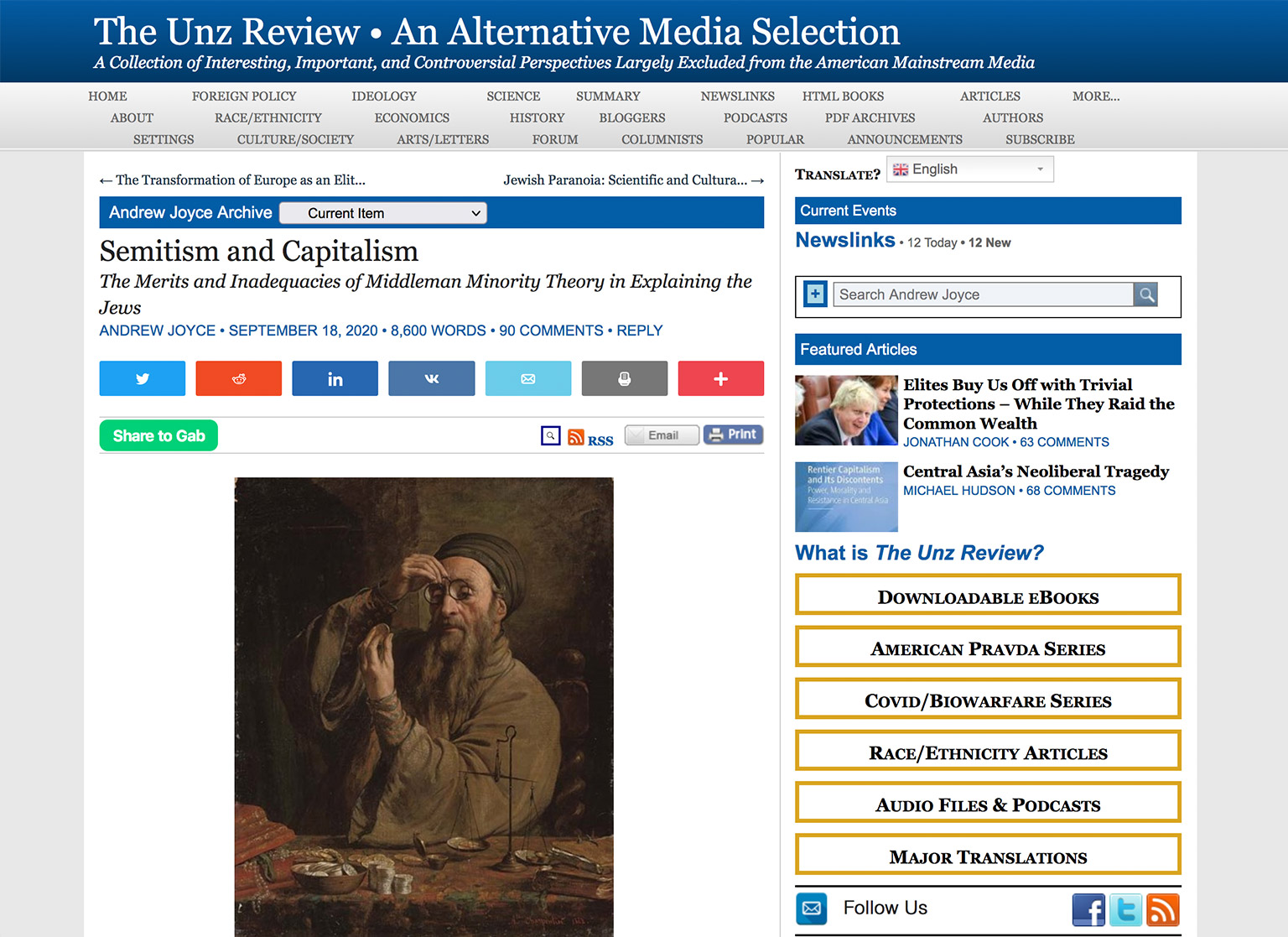
Contemporary examples of hate speech linked to narratives on the erosion of credibility of the financial system
Semitism and Capitalism
The Unz. 18 September 2020
b) Messages of hate and attacks on the alleged loss of sovereignty
The supposed loss of sovereignty by Nation-States is another narrative regularly used by websites spewing hate speech. As happens with hate narratives linked to the delegitimization of the financial system, narratives related to “anti-globalist” content also have a direct (even aesthetic) connection to the discourse that facilitated the rise of the Nazi regime in 20th-century Europe, when caricatures of Jews with beasts’ claws gripping globes were disseminated (image 40). At present, these images appear almost exactly, as can be seen in the examples showing images of Jewish businessmen, such as George Soros, caricatured as insects who try to control territories like the European Union.


Comtemporary examples of hate messages linked to narratives aimed at eroding the sovereignty of Nation-States
Spain continues to be controlled by the Government of Globalist Occupation
Democracia Nacionale. 29 November 2018
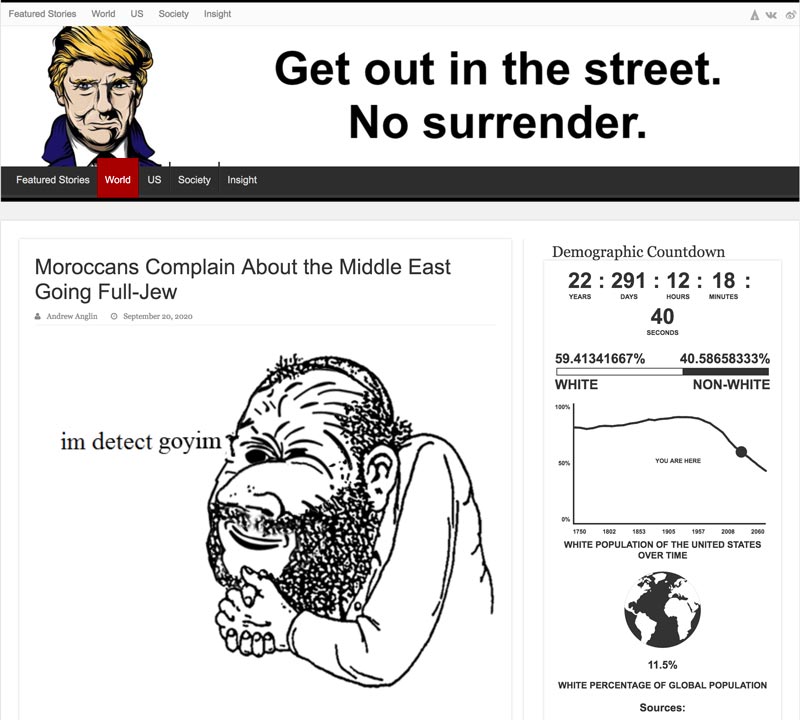
Comtemporary examples of hate messages linked to narratives aimed at eroding the sovereignty of Nation-States
Moroccans Complain About the Middle East Going Full-Jew
Daily Stormer. 5 September 2020

Comtemporary examples of hate message linked to narratives of the erosion of credibility of the financial system
LLa Cabalá explains the swindle of the new world order
Muelgas Gaitán. 17 July 2020
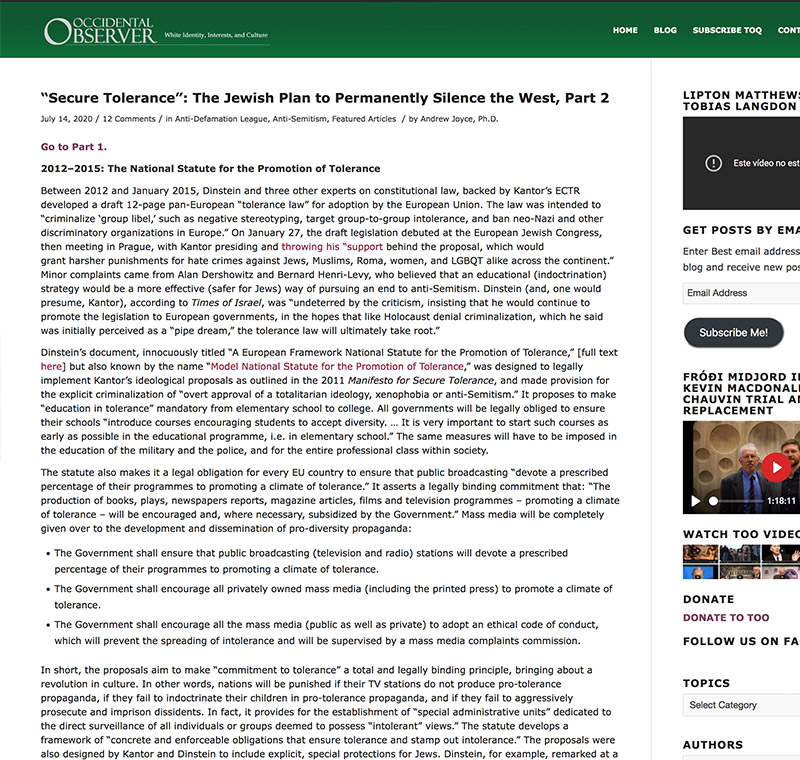
Comtemporary examples of hate message linked to narratives of the erosion of credibility of the financial system
“Secure Tolerance”: The Jewish Plan to Permanently Silence the West
The Occidental Observer. 14 July 2020
c) Hate speech and attacks on the media
The Media, as a key element in the process of moulding public opinion in liberal democracies, is also frequently targeted in narratives linked to the dissemination of hate speech. As in the case of attacks on the financial system, these narratives accuse certain racial, religious or social groups of controlling and manipulating the media with the aim of controlling public opinion in favour of their interests.

Contemporary examples of hate speech linked to narratives of erosion of confidence in mainstream media
The Jewish lobby urges censorship on the Internet and “the imprisonment of company managers who refuse to abide by it”. Rafapal. 2 December 2019
d) Hate speech and narratives that erode the Rule of Law (I)
Respect for the Rule of Law is another pillar that defines systems of governance of liberal democracies. As in the cases of the financial system, the media or national sovereignty, contemporary platforms for the creation and dissemination of hate speech systematically generate narratives that seek to erode citizens’ confidence in the Rule of Law. On a regular basis, these platforms publish content that link racial, religious or social groups with the perpetration of large-scale terrorist attacks (e.g. 11-S), the creation of terrorist groups (like ISIS), or incitement to violent action and protests (such as the Black Lives Matter group). The use of tragic events caused by accidents is also common (e.g. the explosion in the port of Beirut) to create conspiracy theories that link these racial, religious or social groups to deliberate criminal acts.
In a recurrent manner, these platforms publish content that link racial, religious or social groups to the commission of large-scale terrorist attacks (such as 11-S) to the creation of terrorist groups (such as ISIS), or to the promotion of violent actions and protests such as the riots generated by the Black Live Matters group). Tragic events caused by accidents (such as the explosion in the port of Beirut) are also exploited to build conspiracy theories that link these racial, religious or social groups to deliberate criminal acts.

Contemporary examples of hate speech linked to narratives of erosion of confidence in the Rule of Law
Salen a la luz detalles del programa secreto de Israel para armar a rebeldes sirios.
Democracia Nacional. 9 septiembre 2018

Contemporary examples of hate speech linked to narratives of erosion of confidence in the Rule of Law
Remembering 9/11: Traitorous US Elite Complicit in False Flag.
Henry Makow. 11 septiembre 2020

Contemporary examples of hate speech linked to narratives of erosion of confidence in the Rule of Law
11 September: the treacherous US elite, complicit in the false flag
Muelas Gaitán, 11 September 2020

Contemporary examples of hate speech linked to narratives of erosion of confidence in the Rule of Law
9/11: Was an Israel Job The Unz. 10 February 2018

Are these Antifa/BLM Riots a Jewish Coup? Vdare, 12 September 2020

Israel destroys East Beirut with a new weapon Voltaire
Voltaire, 7 August 2020
e) Messages of hate, stigmatisation and attacks on the right to honour and respectability
Another recurrent narrative in contemporary platforms that generate hate messages to delegitimise the Rule of Law is the dissemination of content that links certain racial, religious or social groups to crimes involving exploitation of minors, and that these are tolerated by the Judiciary System and the Security Forces of the State. They seek to remove personal honour from what is, and should be, respect for the individual, and in particular for minors. As has been shown with other content linked to narratives of hate, this type of message is nothing new; it follows a tradition widely used by totalitarian political movement in 20th-century Europe. Images 5 and 6 show pictures published by the Nazi magazine “The Poisonous Mushroom”, in which it is suggested that a man of Jewish appearance is trying to trick some children. Images that show caricatures of Jews slitting the throats of a group of children to collect and then drink their blood also appeared on the cover of “Der Stürmer”.

Image 5: Image in a book from Nazi Germany “The Poisonous Mushroom”

Imagen 6: Image 6: Cover of “Der Stürmer”, May 1934
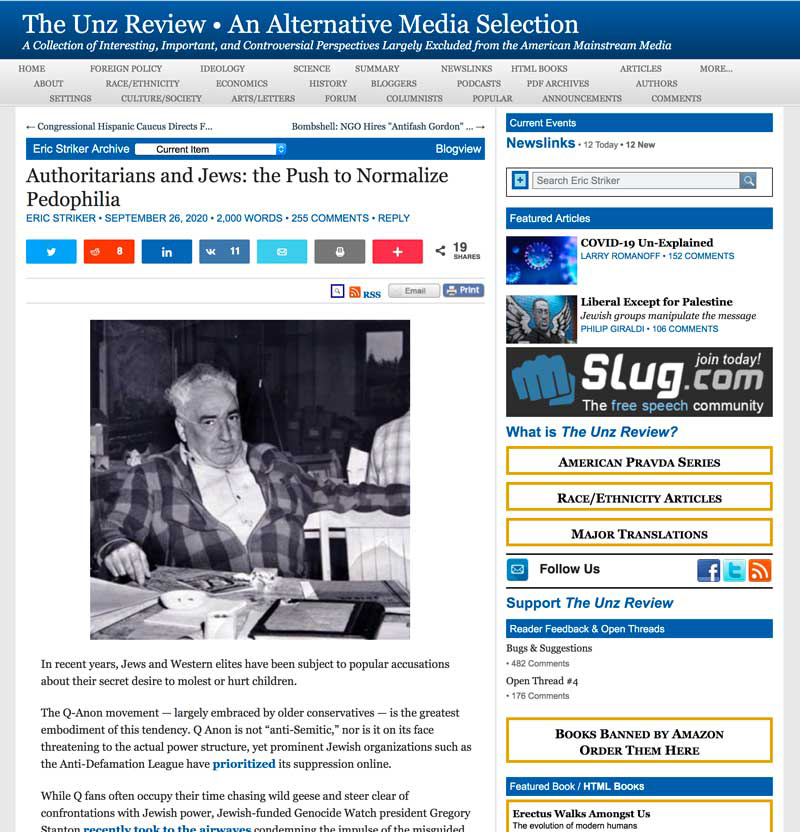
Contemporary examples of messages of hate linked to narratives of erosion of confidence in the Rule of Law (II)
Authoritarians and Jews: The Push to Normalize Pedophilia National Justice.
26 September 2020

Contemporary examples of messages of hate linked to narratives of erosion of confidence in the Rule of Law (II)
Harvey’s Homies: The Weinstein Scandal as Paradigm of Collectivist Jewish Predation on Atomized Gentiles
Occidental Oberver. 24 September 2020
f) Messages of hate and attacks on the health system
The current Covid-19 pandemic is also being used by platforms that generate messages of hate to delegitimise public and multilateral health institutions, accusing them of fooling people about the truth behind the pandemic: a conspiracy created by religious, racial or social groups.

g) Messages of hate and attacks on the academic world and valid sources
Finally, another institution of liberal democracies also discredited and eroded by contemporary platforms that generate messages of hate concerns the academic world and scientific research into History. Platforms that disseminate these messages often resort to pseudo-scientific content and arguments that challenge the studies carried out by historians and promote alternative versions of History that help stigmatise and caricaturise the racial, religious and social groups that they set out to malign.


I don’t doubt the Holocaust (because it is forbidden by law), but…
Falsas Banderas. 27 January 2020

JAJAJAJAJA. Now there are not 6 million Jews who died in the Holocaust. There are 15 or 20 million now! according to Telemadrid!
Falsas Banderas. 21 julio 2017
Coordination between different platforms
Another characteristic feature of contemporary platforms linked to the generation of hate messages and narratives and, in general, malicious communication platforms, is how they network to act as spokespersons and redistributors of malicious content generated by other platforms. In the case of websites that distribute anti-Semitic hate analysed in this study, we have detected a 38% redistribution rate of unoriginal messages. This figure implies that 38% of the 131 anti-Semitic messages detected by these media are not original, but a mere re-dissemination or a “copy and paste” of the content published in another website from the same community.
As can be seen in the examples shown in the following paragraphs, there are a series of media such as “Muelgas Gaitán” or “The Unz” that not only generate original messages of hate, but also act as antennae to re-broadcast the content generated by other platforms from the same ideological community.

Original content
Remembering 9/11: Traitorous US Elite Complicit in False Flag
Henry Makow. 11 septiembre 2020
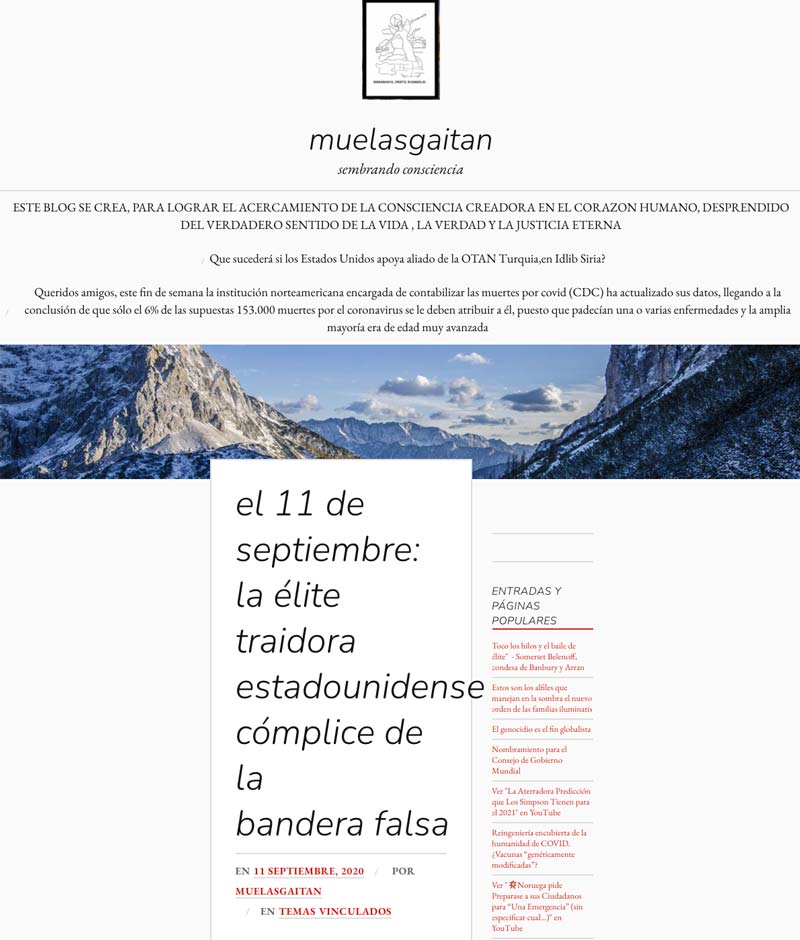
Content redistributed on other platform
Photo caption coordinated across different platforms: 11-S: the treacherous US elite complicit in the false flag.

Original content
Authoritarians and Jews: The Push to Normalize Pedophilia
National Justice. 26 September 2020

Content redistributed on other platform
Authoritarians and Jews: The Push to Normalize Pedophilia
The Unz. 26 September 2020

Original content
Are these Antifa/BLM Riots a Jewish Coup?
Vdare, 12 September 2020

Content redistributed on other platform
Are these antifa/BLM Riots a Jewish Coup?
The Unz, 12 September 2020

Original content
Remembering 9/11: Traitorous US Elite Complicit in False Flag
Henry Makow. 11 September 2020

Content redistributed on other platform
Voltairenet: Israel Destroys East Beirut with new weapon
Voltaire. 8 August 2020

Original content
Israel Destroys East-Beirut with new weapon by Thierry Meyssan 8 August 2020

Content redistributed on other platform
Israel Destroys East-Beirut with new weapon Vida Latinoamericana. 7 August 2020 7 August 2020
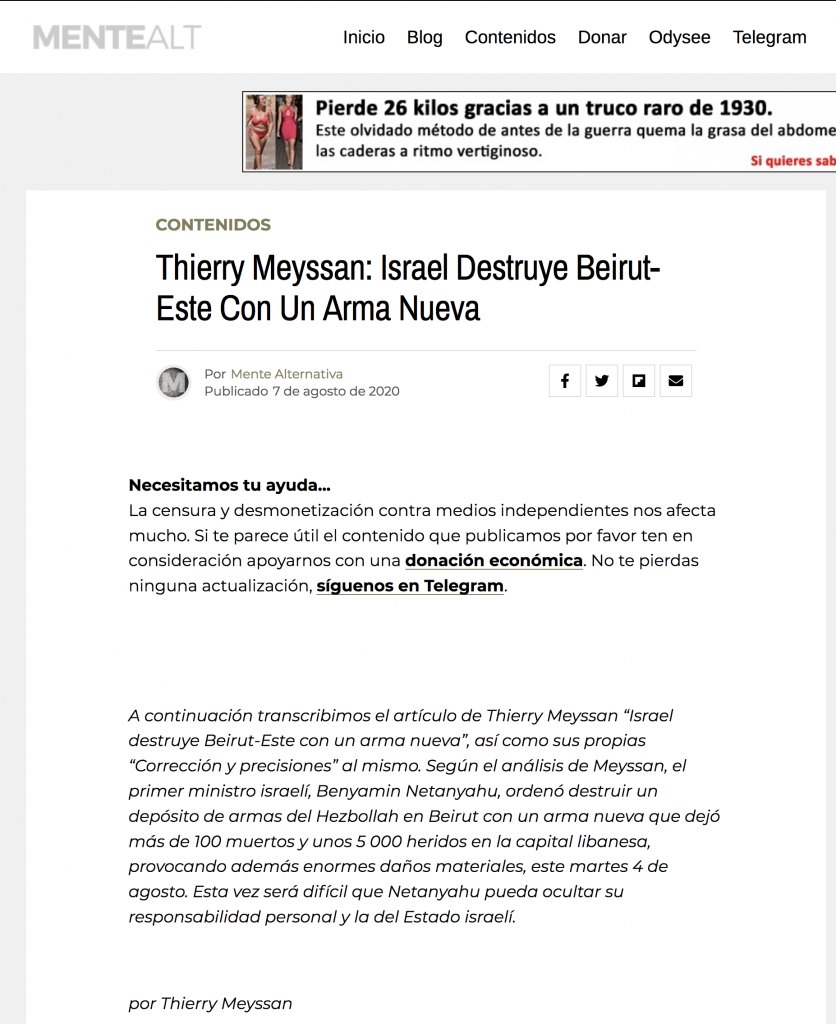
Original content
Israel Destroys East-Beirut with new weapon Vida Latinoamericana. 7 August 2020

Content redistributed on other platform
Israel Destroys East Beirut with a New Weapon
Oriental Review. 10 August 2020
A global strategy
The characteristic narratives shared by contemporary platforms that disseminate messages of hate against the Jewish or immigrant communities are also shared by other websites that stand out for promoting messages of hate or ideological polarisation. In this respect, it is particularly interesting to see how elements such as lack of transparency, rejection of scientific evidence and undermining the pillars of the social contract of liberal democracy are also common in digital platforms of ethno-nationalist ideology that support people linked to terrorist groups like ETA, as in the cases of mpr21 (Political Resistance Movement) or the digital platform Biltzarre. These two websites published content supporting individuals and terrorist organisations such as ETA (image 7 and 8) on several occasions in 2020, while also publishing their messages from completely anonymous websites, while also publishing their messages from completely anonymous websites, including many pseudo-scientific messages and others eroding the credibility of public institutions in liberal democracies (see examples).
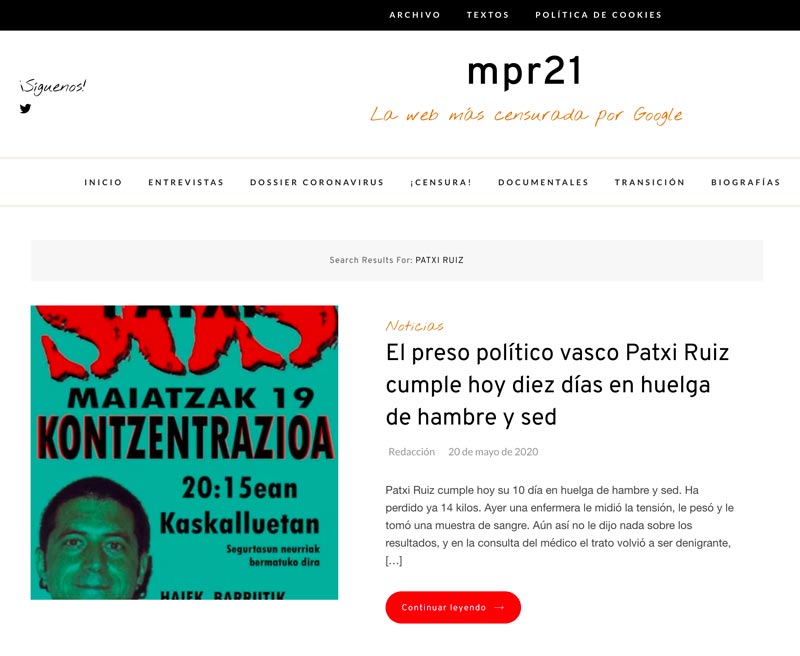
Image 7: Screenshot of the digital platform mpr21, showing support for the ETA terrorist Patxi Ruiz, the perpetrator of several murders in Spain

Image 8: Screeenshot ot the digital platfrom Biltzarre in support of the founders of the terrorist group ETA

Examples of pseudo-scientific content in ideological polarisation, hate, ethno-nacionalist and far-left platforms
The fraud of the pandemic starts to come to light in several countries around the world.
Movimiento Político Resistencia. 21 May 2020
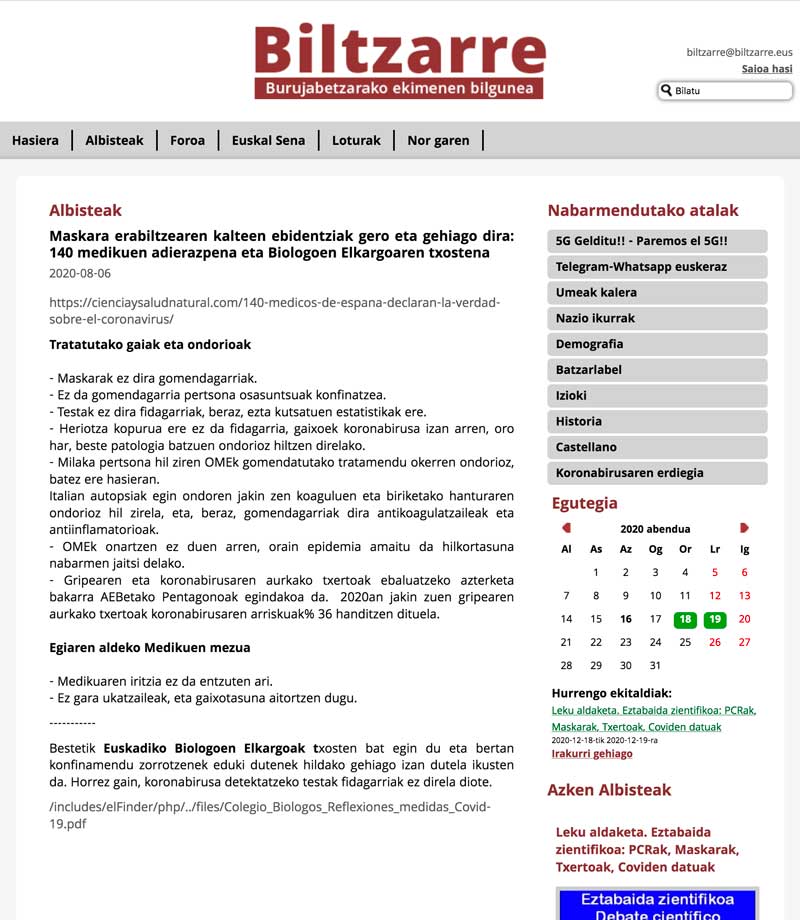
Examples of pseudo-scientific content in ideological polarisation, hate, ethno-nacionalist and far-left platforms
There is growing evidence of harm from using face coverings: a statement by 140 doctors and report by Association of Biologists.
Biltzarre. 6 August 2020
The case of the digital platform Lahaine
One clear example of this is the digital platform linked to extreme left anti-system movements in Spain: Lahaine.org.
This platform, as shown in images 9, 10, 11 and 12, systematically disseminates messages of hate against Spanish members of the State security forces, and openly shows its support for the terrorist group ETA.
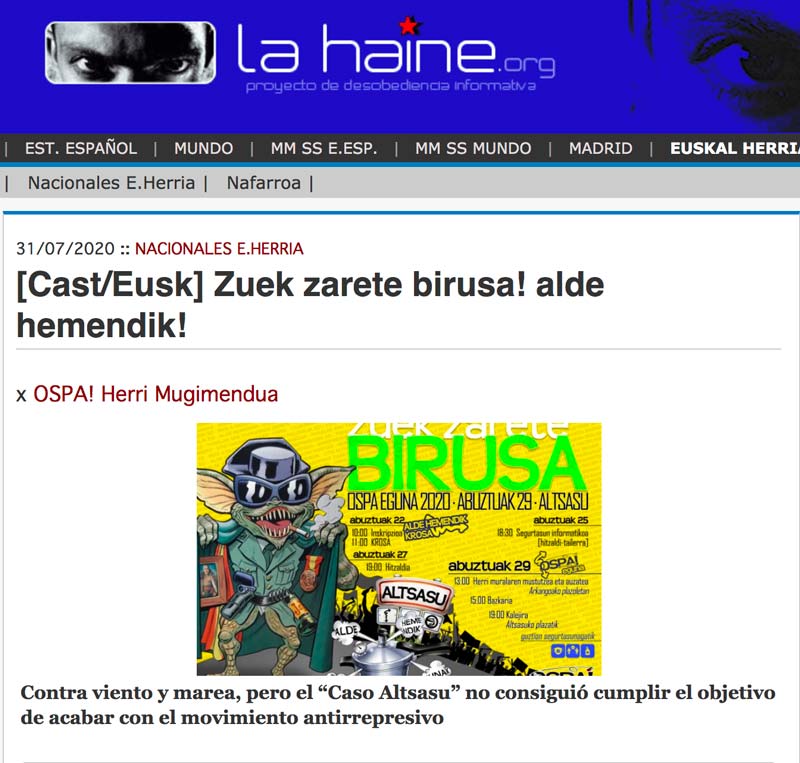
Hate content disseminated by the extreme left Spanish platform
La Haine
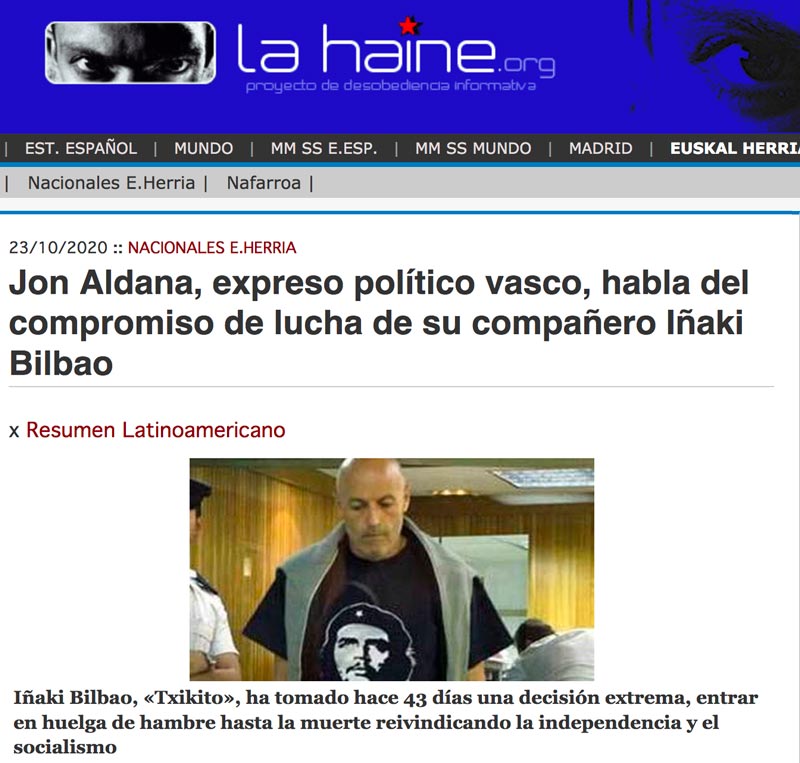
Hate content disseminated by the extreme left Spanish platform
La Haine
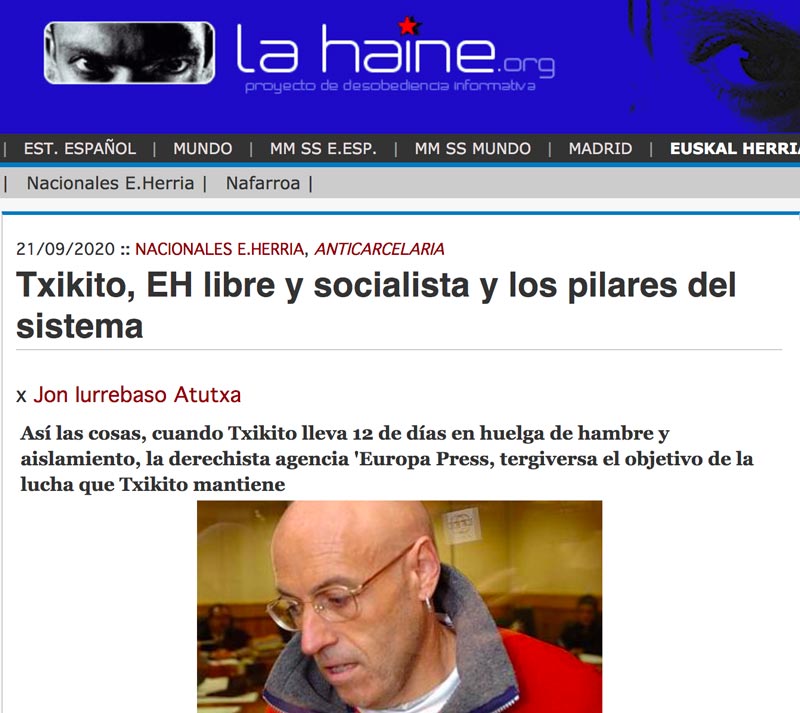
Hate content disseminated by the extreme left Spanish platform
La Haine
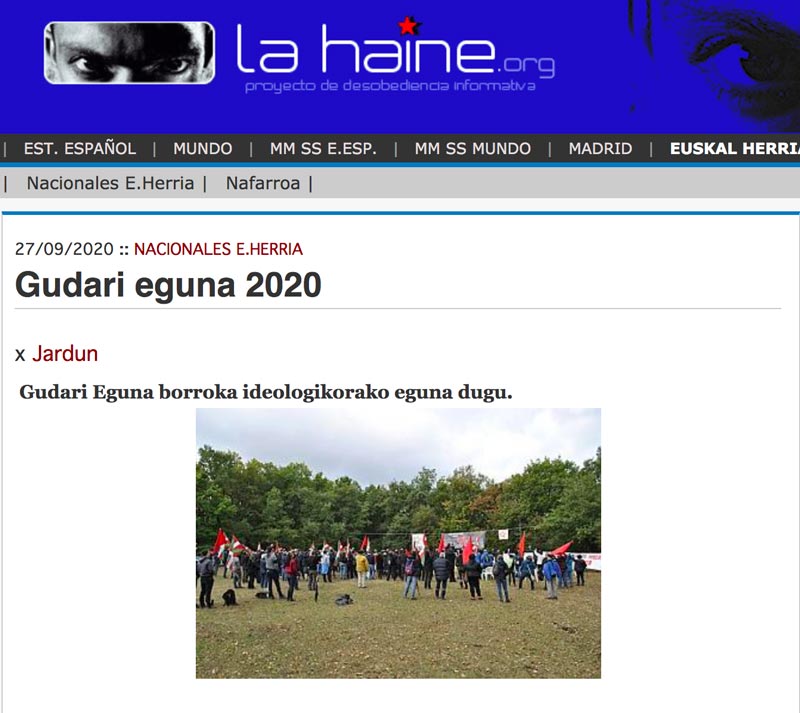
Hate content disseminated by the extreme left Spanish platform
La Haine

Pseudo-scientific, conspirational and anti-system content disseminated by the Spanish extreme left platform. La Hain
Scientists: coronavirus would be a biological
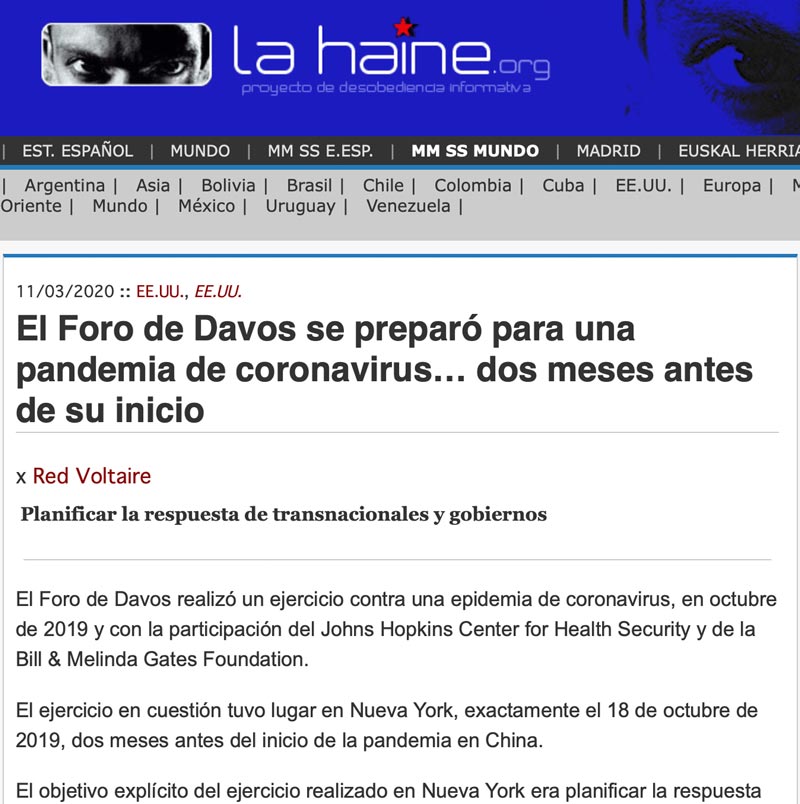
Pseudo-scientific, conspirational and anti-system content disseminated by the Spanish extreme left platform. La Hain
The Davos Forum prepared for a coronavirus pandemic, two months before it began
La Haine. 11 March 2020

Coronavirus: biological warfare or natural illness?
La Haine, 17 March 2020

Corononavirus: a war without soldiers?
La Haine, 18 March 2020

Implementation of 5G of coronavirus
La Haine. 6 April 2020/small>
Conclusions on spreading hate in social media
Messages of hate against groups of people for their race, religion or political or social status are still prevalent, and continue to have an open and systematic impact on public opinion in liberal democracies through social media.
Dozens of digital platforms create and publish these messages in Europe and North America on a daily basis. These platforms not only have a common narrative of hate, but they also share a series of technical features:
They show a lack of transparency regarding their origins, the people behind them and their funding
They share an interest in disseminating pseudo- and anti-scientific narratives as a way of vdiscrediting scientific thought, the main basis of modern liberal democracies
The hate content that these platforms create and disseminate are regularly linked to messages aimed at eroding the credibility of key elements of the liberal social contract: financial system, Rule of Law, the media, academia and the sovereignty of Nation States
As well as these common elements, other indicators such as the high repetition rate of the same content on different platforms of the same characteristics, showing that the proliferation of messages of hate
can be linked to a strategy to destabilise and break down the social cohesion of the liberal democracies in Europe and the United States and promote authoritarian anti-modern political movements.

